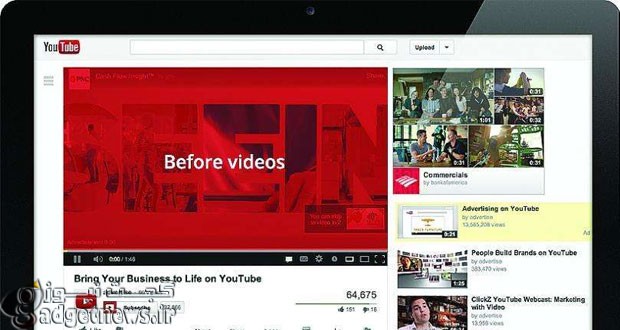هر برندی دوست دارد تا جایی که امکان دارد افراد را به تماشای تبلیغات خود ترغیب کند، اما هر یک با استراتژی های خاص خود این کار انجام می دهد. درادامه قصد داریم روش های تبلیغاتی سرویس یوتیوب و شبکه اجتماعی فیسبوک را از جنبه های مختلف که عبارت اند از مخاطب، هدف مندی، هزینه و روش های تبلیغاتی Autoplay و Skippable مورد مقایسه قرار دهیم.
مخاطب
هدف اصلی از رفتن به سایت یوتیوب تماشا کردن ویدیو است بنابراین بازدیدکنندگان این سرویس ممکن است بیشتر در معرض تماشای تبلیغات قرار گیرند اما بر عکس فیسبوک، یک کاربر یوتیوبی بیشتر به لحاظ صوتی از محتوای تبلیغاتی استفاده می کند. با این حال افراد زمانیکه به فیسبوک خود سر می زنند ویدیوهای یوتیوب را می بینند که اکنون به طور متوسط در هر روز 3 میلیارد ویدیو می باشد.
هدف مندی
برای تماشای یک ویدیوی تبلیغاتی از فیسبوک، فرد باید به اکانت شخصی خود وارد شود که این باعث می شود با توجه به اطلاعاتی که وی پیش از این در زمان ساخت اکانتش در مورد خود پر کرده است تبلیغات هدف مند شده شوند و بر اساس علایق، سن، و غیره برای فرد تبلیغات ارائه شود. یوتیوب هم از طبقه بندی های هدف مندی مشابه برای تبلیغات خود استفاده می کند اما طرز هدفمند کردن تبلیغات آن با فیسبوک از جهاتی متفاوت است.
هزینه
علاوه بر فروش مستقیم تبلیغات ویدیویی، فیسبوک و یوتیوب هر دو از ابزار “خود خدمات” استفاده می کنند، اما به روش های مختلف. تبلیغ کنندگان برای هر دوی این شرکت ها بودجه ای وارد می کند. برای مثال فیسبوک به برندها زمانیکه یک میزان مشخصی از لایک یا کامنت ها برای تبلیغ گذاشته شد هزینه می پردازد و یوتیوب بر اساس تعداد دفعاتی که یک ویدیوی تبلیغاتی در روز دیده می شود و همچنین متوسط مخاطبینی که از آن بازدید به عمل آوردند.
تبلیغات یوتیوب (Skippable) در مقابل تبلیغات فیسبوک (Autoplay)
یکی از مزایای تبلیغات یوتیوب در این است که تبلیغ کنندگان تنها زمانی که بازدیدکنندگان ویدیوی تبلیغاتی را تا آخر دیدند پول دریافت می کنند که در نتیجه هزینه دقیق هر بازدید را می توان تعیین کرد. فیسبوک از طرفی بعد از آنکه ویدیو پس از سه ثانیه مورد بازدید قرار می گیرد و لایک و کامت می خورد به تبیلغ کنندگان پول می دهد که البته اینگونه نمی توان با دقت کافی میزان هزینه ها را سنجید و عموما رده بندی بازدید از یک ویدیوی تبلیغاتی در فیسبوک در سه مرحله 50، 75، و 100 درصدی است و بر اساس همین رده بندی به تبلیغ کنندگان وجه پرداخت می شود.
منبع : adage
Facebook vs. YouTube: What Does Your Video-Ad Buy Get You?
Facebook vs. YouTube: What Does Your Video-Ad Buy Get You?
Brands want as many people to watch their video ads as possible. But they only want to pay for the people who actually watch their videos. Facebook’s autoplay video ads cover the former; YouTube’s skippable TrueView spots offer the latter. How’s an advertiser to choose?
“You have to look at all the factors. Autoplay vs. skippable is just one thing. You have to look at targeting, cost and, most importantly, how your audiences are engaging with content,” said Kevin Lange, senior VP-social media at Starcom MediaVest Group. Here’s how the two stack up.
Audience
The whole point of going to YouTube is to watch videos, so visitors may be more open to watch an ad — and listen to it. “Unlike Facebook, a user watching a YouTube clip is more likely to be consuming content with sound,” said Kevin Cronin, partner-integrated investment in social and search at UM. However, people are increasingly watching videos when they visit Facebook, which now averages 3 billion video views each day.
Targeting
To watch a video ad on Facebook, a person has to be logged in to his or her account. That lets advertisers target their Facebook video ads very specifically to a potential audience’s age, gender, location and interests. “In terms of targeting, Facebook is still second to none in both segments and accuracy,” Mr. Cronin said.
YouTube offers similar targeting categories, but they don’t match Facebook’s specificity at scale, agency execs said. Some advertisers have compensated by contextually targeting their YouTube ads, aiming them at channel categories like fashion and do-it-yourself, said MEC’s head of social for North America, Noah Mallin.
Cost
In addition to selling videos ads directly, Facebook and YouTube each offer self-serve tools, but they work in different ways. For both, an advertiser enters a budget and who it’s targeting. Facebook’s tool offers a fixed cost per thousand impressions and estimated impressions per day. YouTube asks the brand to enter the maximum it would pay for a completed view. YouTube then estimates the average cost per view and how many views a day. Caveat: What a brand spends may be less than its budget, depending on how many impressions Facebook can serve (even if they aren’t fully watched) and how many views YouTube can deliver. Facebook’s self-serve tool also sells video ads through auctions. Overall, the two products don’t differ greatly in price when factoring in variables like goals and valued metrics, according to Mr. Lange.
Autoplay vs. Skippable
Price and cost are not the same thing.”One huge pro of YouTube’s skippable TrueView ads is that advertisers are only charged when the viewer views the entire ad, resulting in a more accurate cost per view,” Mr. Cronin said. Facebook charges advertisers by the view and starts counting views after a video has played for three seconds.
“With Facebook, especially with it being autoplay and three seconds considered a view, it’s important to make sure the reported views are translating,” Mr. Lange said. Facebook reports details like how many views lasted for 50%, 75% and 100% of the video, so that advertisers can calculate the effective cost of an autoplay ad.
 گجت نیوز آخرین اخبار تکنولوژی، علم و خودرو
گجت نیوز آخرین اخبار تکنولوژی، علم و خودرو 






